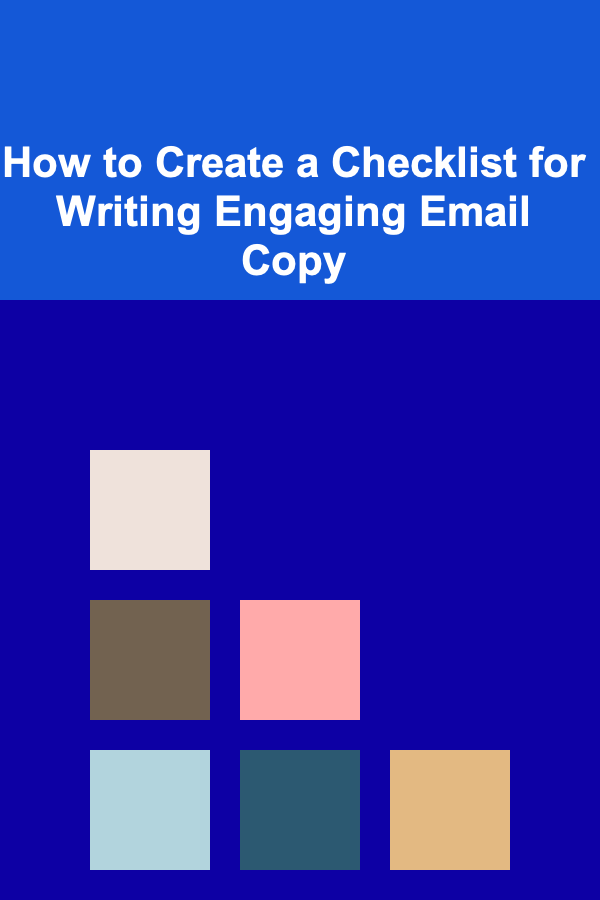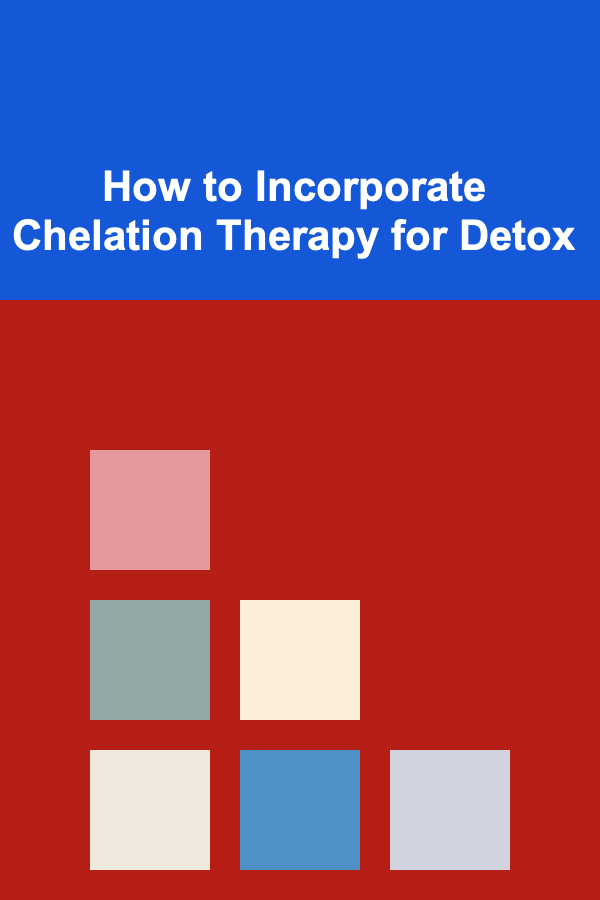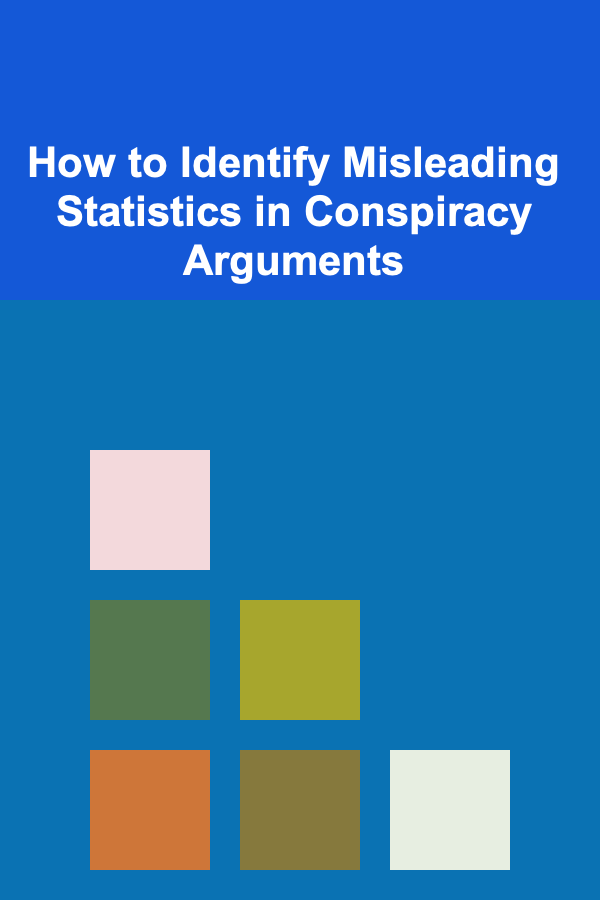
How to Create a Checklist for Writing Engaging Email Copy
ebook include PDF & Audio bundle (Micro Guide)
$12.99$11.99
Limited Time Offer! Order within the next:

Writing engaging email copy is a critical skill for anyone involved in marketing, sales, or customer relations. Emails are one of the most direct ways to communicate with your audience, and if done right, they can drive significant results. Whether you're sending promotional emails, newsletters, or transactional messages, your copy must resonate with your readers and motivate them to take action.
Creating a checklist for writing engaging email copy ensures consistency, helps maintain high standards, and allows you to focus on key elements that will boost engagement and conversions. In this guide, we'll break down actionable steps to create an effective checklist for writing email copy that truly resonates with your audience.
Understand Your Audience
Before you start writing, the first thing you need to do is understand your audience. Your email copy should speak directly to their needs, pain points, and desires. Without this foundational understanding, it's difficult to create messages that connect.
Actionable Tips:
- Create Customer Personas: Develop a detailed profile of your ideal customer(s), including their demographics, interests, behaviors, and common problems.
- Segment Your Email List: Not all recipients are the same. Segment your list based on factors such as purchase history, location, engagement level, or preferences to tailor your emails effectively.
Checklist for Audience Understanding:
- [ ] Have I created detailed customer personas?
- [ ] Have I segmented my email list for personalized messaging?
Craft a Compelling Subject Line
The subject line is the first thing your recipients will see, and it significantly influences whether they'll open your email. It should be compelling, clear, and intriguing enough to grab their attention.
Actionable Tips:
- Keep It Short and Sweet: Aim for subject lines between 6-10 words for optimal engagement. Shorter subject lines are more likely to be opened on mobile devices.
- Create a Sense of Urgency or Curiosity: Use words that create curiosity or urgency, such as "limited time," "don't miss out," or "exclusive."
- Avoid Spammy Language: Steer clear of using words that trigger spam filters, like "free," "guaranteed," or "earn money."
Checklist for Subject Line:
- [ ] Is the subject line clear and concise?
- [ ] Does it create curiosity or urgency?
- [ ] Have I avoided words that could trigger spam filters?
Personalize Your Greeting
Personalization can dramatically improve the engagement of your email. Starting your email with the recipient's name can create a more personal connection, making them feel like the message is tailored to them.
Actionable Tips:
- Use First Names: If possible, use the recipient's first name in the greeting. For example, "Hi [First Name],"
- Segment Based on Interests: Personalize not just by name, but also by the recipient's interests or past behavior. You can say things like, "Based on your recent purchase of X, we thought you'd love this..."
Checklist for Greeting:
- [ ] Have I personalized the greeting with the recipient's name?
- [ ] Have I customized the message based on recipient behavior or interests?
Start with a Strong Hook
The opening sentence should immediately grab the reader's attention. It sets the tone for the rest of the email and encourages the recipient to keep reading.
Actionable Tips:
- Use Emotional Triggers: Start with a question, problem, or statement that taps into the reader's emotions or pain points. For example, "Tired of spending hours on X?"
- Be Clear and Direct: Ensure the reader knows exactly what the email is about within the first few lines.
Checklist for Hook:
- [ ] Does the opening sentence capture attention immediately?
- [ ] Does it address the reader's pain point, need, or desire?
Focus on the Benefits, Not Just Features
When writing email copy, it's important to focus on how your product or service benefits the reader, rather than just listing features. Benefits show the reader how your offer improves their life or solves their problem.
Actionable Tips:
- Answer "What's in it for me?": Whenever you mention a feature, follow it up with a benefit. For example, "Our new smartwatch tracks your steps (feature), helping you stay fit and motivated (benefit)."
- Use Testimonials or Case Studies: Provide social proof to demonstrate how your product has helped others achieve their goals.
Checklist for Benefits and Features:
- [ ] Have I highlighted the benefits of the offer?
- [ ] Have I demonstrated how the product solves a problem or improves the reader's life?
Create a Clear and Concise Call to Action (CTA)
The CTA is the most important part of your email. It tells your reader exactly what action they should take next, whether it's making a purchase, downloading a resource, or contacting your company.
Actionable Tips:
- Be Direct: Use actionable verbs that clearly tell the reader what to do, such as "Buy Now," "Sign Up Today," or "Claim Your Offer."
- Create Urgency: Phrases like "Limited time offer" or "Act before [date]" can prompt recipients to take immediate action.
- Use One Primary CTA: Too many calls to action can confuse the reader. Stick to one primary CTA to increase focus.
Checklist for CTA:
- [ ] Is the CTA clear and easy to understand?
- [ ] Does the CTA create a sense of urgency or importance?
- [ ] Is there only one primary CTA?
Use Persuasive Language and Storytelling
Effective email copy often uses persuasive language that resonates with the reader's desires and needs. Incorporating storytelling into your email can also help make the message more relatable and memorable.
Actionable Tips:
- Use "You" Instead of "I" or "We": Focus the message on the reader. This makes the email feel more about them and less about you.
- Tell a Story: A short, compelling story or anecdote can humanize your brand and create an emotional connection with the reader.
Checklist for Persuasion and Storytelling:
- [ ] Does the email focus on the reader's needs and desires?
- [ ] Have I used a story or anecdote to make the message more engaging?
Maintain Readability and Flow
Your email should be easy to read and scan quickly. Long paragraphs can overwhelm the reader and may cause them to bounce before finishing the email.
Actionable Tips:
- Use Short Paragraphs: Break your content into digestible sections with a paragraph length of 2-3 sentences.
- Bullet Points and Subheadings: If the content is detailed, use bullet points or numbered lists to make it easier to scan.
- Highlight Key Points: Bold or underline important phrases to draw attention to key benefits or CTAs.
Checklist for Readability:
- [ ] Have I used short paragraphs for easy reading?
- [ ] Is the email scannable, with clear headings, bullet points, or bolded text?
- [ ] Does the email flow logically from one section to the next?
Use a Professional Signature
Your email signature is an important aspect of your communication. It can lend credibility to your message and provide the recipient with easy ways to contact you.
Actionable Tips:
- Include Your Name and Title: A professional signature includes your full name and your role in the company.
- Provide Contact Information: Consider adding your company's contact info, social media handles, or a link to your website.
Checklist for Signature:
- [ ] Does my email include a professional signature with my name and title?
- [ ] Is the contact information easy for the reader to access?
Proofread and Edit Your Email
Before hitting send, always proofread your email to catch any spelling, grammar, or formatting mistakes. Even small errors can diminish the professionalism of your message.
Actionable Tips:
- Read Aloud: Reading the email out loud helps you catch awkward phrasing or missed words.
- Use Grammar Tools: Tools like Grammarly can help you ensure your email is grammatically correct.
Checklist for Proofreading:
- [ ] Have I checked for spelling and grammar errors?
- [ ] Have I read the email aloud to ensure it sounds natural?
By following this checklist, you can create email copy that grabs attention, resonates with your audience, and drives action. Engaging email copy is a powerful tool for connecting with your customers and building long-term relationships. Keep refining your emails with each send, and you'll continue to improve your results.
Reading More From Our Other Websites
- [Home Soundproofing 101] How to Minimize Noise from Outside with Effective Soundproofing
- [Survival Kit 101] Top 10 Wilderness Survival Tips: How to Stay Alive in the Wild
- [Personal Care Tips 101] How to Combine Lipstick and Lip Gloss for a Voluminous Effect
- [Trail Running Tip 101] Finding Your Flow: How Trail Running Connects You to the Wild
- [Whitewater Rafting Tip 101] The Best Rafting Life Jackets of 2025: Reviews and Comparisons
- [Personal Care Tips 101] How to Layer Aftershave with Other Skincare Products
- [Horseback Riding Tip 101] Must-Have Horse Riding Accessories for Every Equestrian
- [Home Storage Solution 101] How to Make the Most of Under-Cabinet Storage in Your Kitchen
- [Organization Tip 101] What Should You Know About Organizing Digital Files and Photos?
- [Home Staging 101] How to Stage a Home with Vintage or Antique Furniture

How to Make Sure Your Home Party Is Comfortable for All Guests
Read More
How to Organize Your Tools for Easy Home Repairs
Read More
How to Use Fabric to Transform Your Home Decor
Read More
How to Incorporate Chelation Therapy for Detox
Read More
How to Identify Misleading Statistics in Conspiracy Arguments
Read More
How to Prepare for the ASCP MLT Exam: A Comprehensive Guide
Read MoreOther Products

How to Make Sure Your Home Party Is Comfortable for All Guests
Read More
How to Organize Your Tools for Easy Home Repairs
Read More
How to Use Fabric to Transform Your Home Decor
Read More
How to Incorporate Chelation Therapy for Detox
Read More
How to Identify Misleading Statistics in Conspiracy Arguments
Read More